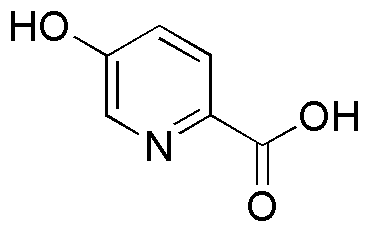5-Hydroxy-pyridine-2-carboxylic acid is widely utilized in research focused on:
- Pharmaceutical Development: This compound serves as an important intermediate in the synthesis of various pharmaceuticals, particularly those targeting neurological disorders. Its unique structure allows for the development of drugs with enhanced efficacy.
- Agricultural Chemistry: It is used in formulating agrochemicals that improve crop yield and resistance to pests. By incorporating this compound, products can be developed that are more effective while being environmentally friendly.
- Biochemical Research: Researchers utilize this compound in studies related to enzyme inhibition and metabolic pathways. Its ability to interact with biological systems makes it a valuable tool for understanding complex biochemical processes.
- Analytical Chemistry: It is employed as a standard in various analytical methods, including chromatography and spectroscopy. This ensures accurate measurements and helps in the quality control of chemical products.
- Material Science: The compound is explored for its potential in developing new materials, including polymers and coatings. Its properties can enhance the durability and functionality of materials used in various applications.
General Information
Properties
Safety and Regulations
Applications
5-Hydroxy-pyridine-2-carboxylic acid is widely utilized in research focused on:
- Pharmaceutical Development: This compound serves as an important intermediate in the synthesis of various pharmaceuticals, particularly those targeting neurological disorders. Its unique structure allows for the development of drugs with enhanced efficacy.
- Agricultural Chemistry: It is used in formulating agrochemicals that improve crop yield and resistance to pests. By incorporating this compound, products can be developed that are more effective while being environmentally friendly.
- Biochemical Research: Researchers utilize this compound in studies related to enzyme inhibition and metabolic pathways. Its ability to interact with biological systems makes it a valuable tool for understanding complex biochemical processes.
- Analytical Chemistry: It is employed as a standard in various analytical methods, including chromatography and spectroscopy. This ensures accurate measurements and helps in the quality control of chemical products.
- Material Science: The compound is explored for its potential in developing new materials, including polymers and coatings. Its properties can enhance the durability and functionality of materials used in various applications.
Documents
Safety Data Sheets (SDS)
The SDS provides comprehensive safety information on handling, storage, and disposal of the product.
Product Specification (PS)
The PS provides a comprehensive breakdown of the product’s properties, including chemical composition, physical state, purity, and storage requirements. It also details acceptable quality ranges and the product's intended applications.
Certificates of Analysis (COA)
Search for Certificates of Analysis (COA) by entering the products Lot Number. Lot and Batch Numbers can be found on a product’s label following the words ‘Lot’ or ‘Batch’.
Número de catálogo
Número de lote/lote
Certificates Of Origin (COO)
This COO confirms the country where the product was manufactured, and also details the materials and components used in it and whether it is derived from natural, synthetic, or other specific sources. This certificate may be required for customs, trade, and regulatory compliance.
Número de catálogo
Número de lote/lote
Safety Data Sheets (SDS)
The SDS provides comprehensive safety information on handling, storage, and disposal of the product.
DownloadProduct Specification (PS)
The PS provides a comprehensive breakdown of the product’s properties, including chemical composition, physical state, purity, and storage requirements. It also details acceptable quality ranges and the product's intended applications.
DownloadCertificates of Analysis (COA)
Search for Certificates of Analysis (COA) by entering the products Lot Number. Lot and Batch Numbers can be found on a product’s label following the words ‘Lot’ or ‘Batch’.
Número de catálogo
Número de lote/lote
Certificates Of Origin (COO)
This COO confirms the country where the product was manufactured, and also details the materials and components used in it and whether it is derived from natural, synthetic, or other specific sources. This certificate may be required for customs, trade, and regulatory compliance.


